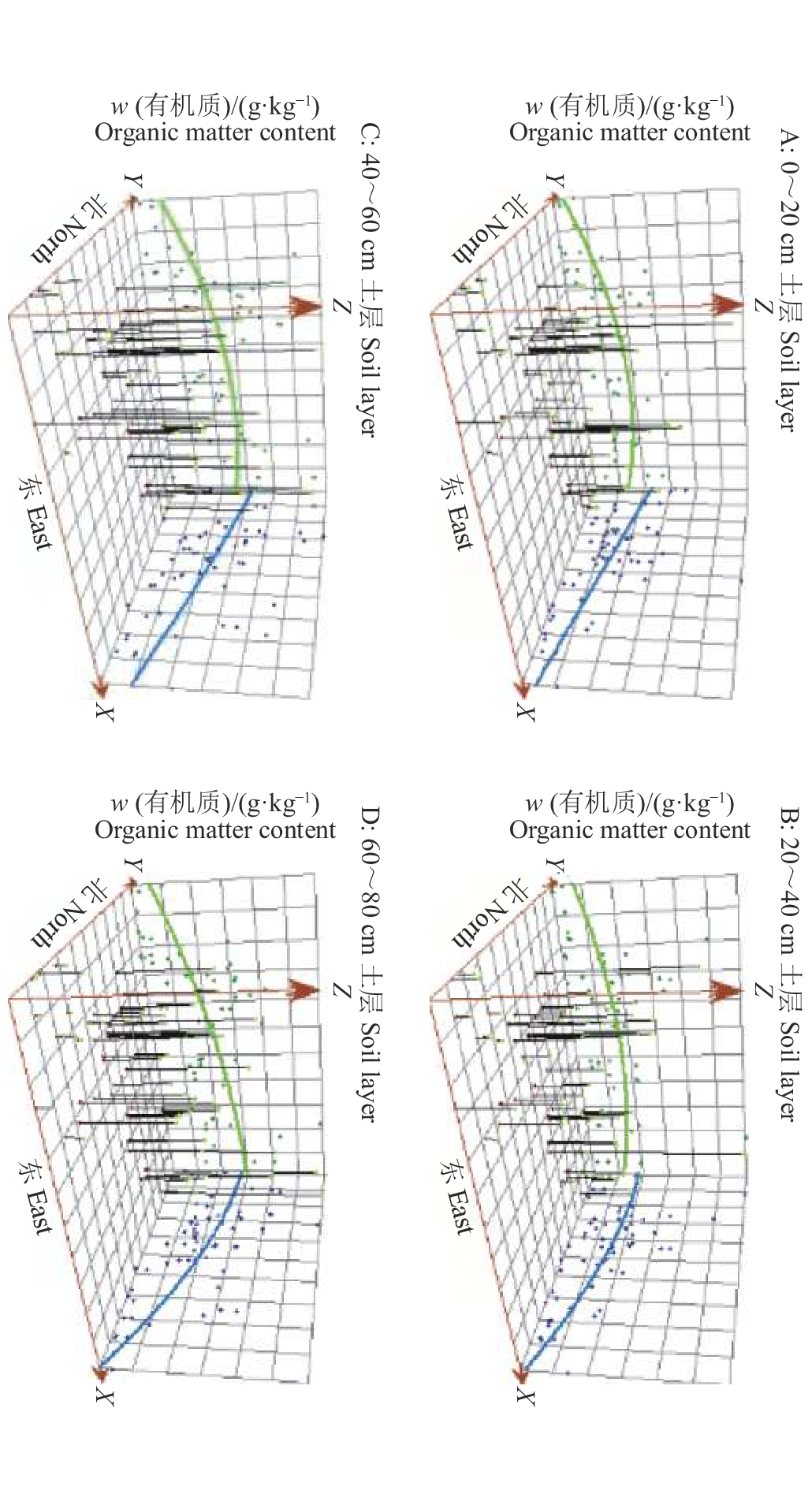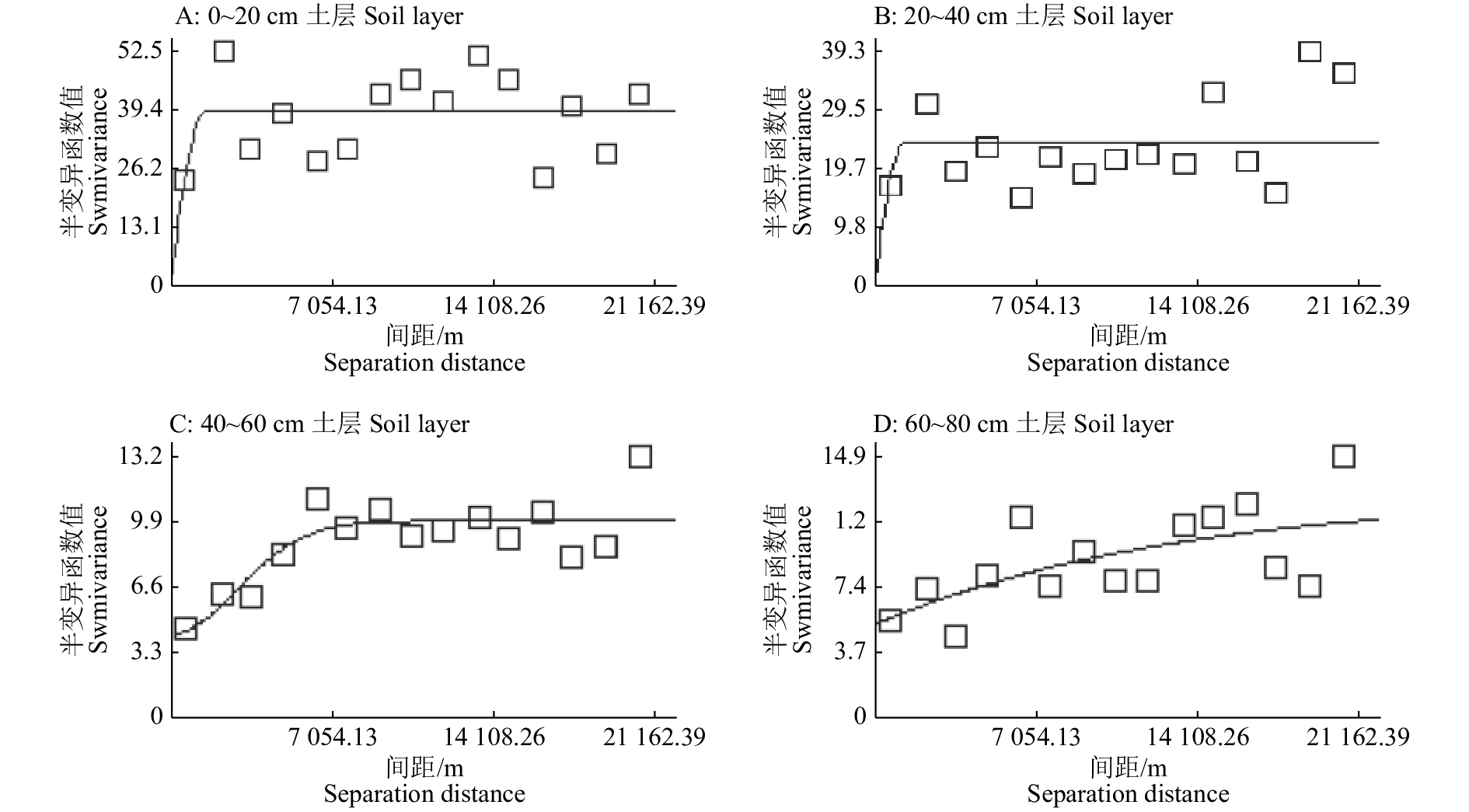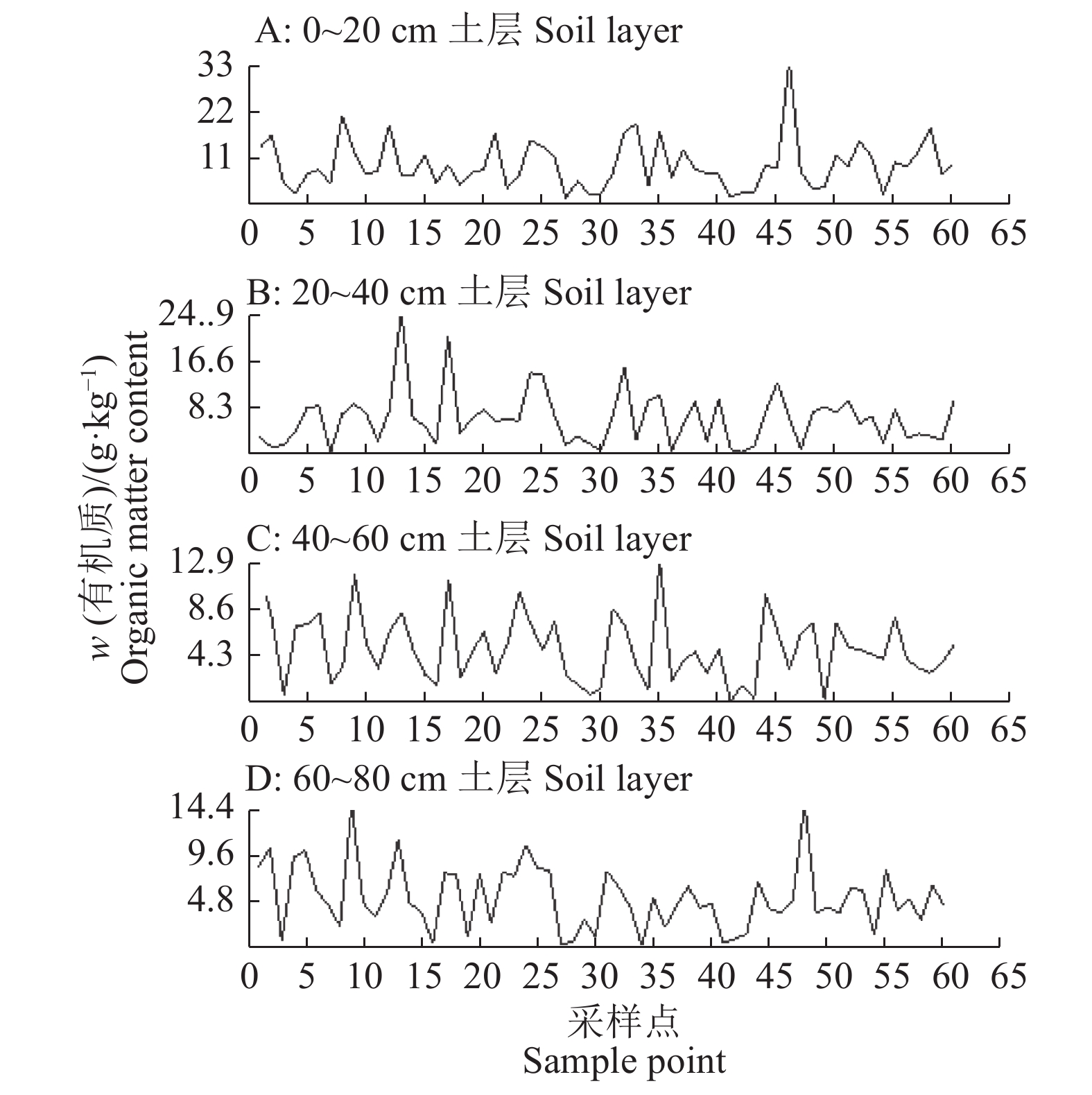Spatial heterogeneity of soil organic matter in Mayi lake area of Karamay city
-
摘要:目的
研究克拉玛依市东部生态屏障的水源地玛依湖区土壤有机质的空间分布规律, 为湖区的生态环境保护提供科学依据和数据支撑。
方法以玛依湖区为研究对象,通过野外采样和室内分析,利用趋势分析法、反距离权重插值法、空间自相关法和半变异函数法分析玛依湖区不同土层深度土壤有机质的空间分布规律。
结果趋势法分析表明,玛依湖区土壤有机质含量在0~20、20~40、40~60和60~80 cm土层的变化速率存在差异,整体趋势为土壤有机质含量南北方向呈增加趋势、东西方向呈减少趋势。反距离权重插值法(IDW)研究表明,玛依湖区不同土层土壤有机质水平分布差异较大,局部地区土壤有机质含量存在明显的垂直分布特征,土壤有机质含量变化趋势同趋势法分析结果高度一致,整体表现为土壤有机质含量南北方向呈增加趋势、东西方向呈减少趋势。空间自相关法研究表明,0~20、20~40、40~60和60~80 cm土层的Moran指数分别为0.1643、0.1236、0.1955和0.2461,均在空间上呈现出显著正相关;4个土层的Z值分别为3.1510、2.5934、3.5903和4.6355,底层(40~60和60~80 cm)的土壤有机质空间正相关较显著、空间聚集程度最高,表层(0~20和20~40 cm)空间相关性不显著、空间聚集程度较低。半变异函数分析法表明,底层(40~60和60~80 cm)土层的块金效应分别为0.427和0.420,说明土壤有机质具有一定的空间相关性;表层(0~20和20~40 cm)土层的块金效应分别为0.033和0.045,土壤有机质的空间相关性较弱。
结论不同土层土壤有机质含量水平差异较大,南北方向呈增加趋势,东西方向呈减少趋势,局部地区存在明显的垂直分布特征。土壤有机质在表层(0~20和20~40 cm)空间相关性不显著,空间聚集程度较低;在底层(40~60和60~80 cm)空间相关性较显著,空间聚集程度较高。土壤有机质空间异质性受土壤类型、土壤质地、外围植被类型以及湖区面积变化的影响较大;在湖区外围生态屏障建设时,防护林树种、种植深度、种植密度的选择应当结合土壤有机质含量的空间分布状况进行。
Abstract:ObjectiveTo study the spatial distribution of soil organic matter in Mayi lake, the water source of the eastern ecological barrier of Karamay city, and provide scientific basis and data support for the ecological environment protection of the lake area.
MethodThe study area of this paper was Mayi lake. Through field sampling and indoor analysis, the study used trend analysis method, inverse distance weight interpolation method, spatial autocorrelation method and semi-variogram function method to analyze the spatial distribution law of soil organic matter at different depths of Mayi lake.
ResultThe trend analysis showed that the change rates of soil organic matter content in Mayi lake were different from 0−20, 20−40, 40−60 and 60−80 cm soil layers, but the overall trend was that soil organic matter content increased in the north-south direction and decreased in the east-west direction. The inverse distance weight interpolation method (IDW) showed that there are large horizontal distribution differences of soil organic matter contents in different soil layers, and regional obvious vertical distribution characteristics of soil organic matter content in Mayi lake. The trends in soil organic matter content change were highly consistent with trend analysis method. The overall performance of the north-south direction of soil organic matter content increased, the east-west direction showed a trend of decrease. The spatial autocorrelation method showed that Moran indexes of four layers were 0.164 3, 0.123 6, 0.195 5 and 0.246 1 respectively, showing a significant positive correlation on the space. The Z values of 0−20, 20−40, 40−60 and 60−80 cm soil layers were 3.151 0, 2.593 4, 3.590 3 and 4.635 5 respectively. The soil organic matter of underlayers (40−60, 60−80 cm) had obvious positive spatial correlation with the highest space aggregation degree. The surface layers (0−20, 20−40 cm) had no significant spatial correlation, and low spatial aggregation degree. The semi-variogram function method showed that the nugget effects of the underlayers (40−60 and 60−80 cm) were 0.427 and 0.420 respectively, indicating spatial correlation of soil organic matter was general. The nugget effects of the surface layers (0−20 and 20−40 cm) were 0.033 and 0.045 respectively, indicating high spatial correlation of soil organic matter.
ConclusionThe contents of soil organic matter in different soil layers vary greatly, and the north-south direction tends to increase, while the east-west direction tends to decrease. The spatial correlations of soil organic matter in the surface layers (0−20 and 20−40 cm) are not significant, and the spatial aggregation degrees are low, while the spatial correlations are significant and the spatial aggregation degrees are high in the underlayers (40−60 and 60−80 cm). The spatial heterogeneity of soil organic matter content is greatly affected by soil type, soil texture, vegetation type and the variation of lake area. While constructing ecological barrier in the periphery of lake area, the selection of shelterbelt tree species, planting depth and planting density should be combined with the spatial distribution of soil organic matter content.
-
子宫内膜炎是母猪在生产过程中或产后受到大肠埃希菌、链球菌、葡萄球菌等病原微生物侵袭而引发的炎症[1]。患病后会导致母猪泌乳量减少、发情周期紊乱、屡配不孕,增大母猪的淘汰率[2],给养猪场带来巨大的经济损失,因此选择合适的药物和给药途径治疗母猪子宫内膜炎十分重要。多西环素是四环素类广谱抗菌药,目前在兽医临床上主要用于治疗畜禽由大肠埃希菌、沙门氏菌、支原体等病原微生物感染的疾病[3],与其他同类药物相比具有抗菌活性强、体内分布广、生物利用度高等优点[4]。有研究指出,多西环素对奶牛子宫内膜炎有很好的治疗效果[5],而且组织穿透能力强,因此常用于治疗子宫内膜炎等器官深部感染性炎症。
子宫内膜炎是发生在子宫这种深部器官的炎症,若采取肌肉注射的方式,药物很难到达作用部位起到治疗效果,因此一般采用子宫灌注的方式对母猪子宫内膜炎进行治疗。但普通的子宫灌注液到达子宫内时为液体状态,易流动导致药物损失,从而降低治疗效果,因此研制出一种定位准确且能减少药物损失的制剂尤为重要。温度敏感型原位凝胶是一种新型给药系统,以液体状态给药后,受给药部位温度的变化能发生相转变形成半固体凝胶[6],目前已广泛应用于鼻腔[7-9]、眼部[10-11]、阴道[12]等部位给药。与传统子宫灌注液相比,温度敏感型原位凝胶子宫灌注液到达子宫后变为半固体状态,更易黏附在子宫内,不易流失,在提高患病部位局部药物浓度的同时还具有缓释效果。
本研究选择温敏型原位凝胶给药系统,以多西环素为主药、泊洛沙姆407(P407)和泊洛沙姆188(P188)为主要的温敏材料,经处方筛选和优化后,研制出一种多西环素温敏型原位凝胶子宫灌注液,对其进行了体外溶蚀考察和质量评价,并对给药后该制剂在子宫内的药物浓度进行了监测,为临床使用多西环素治疗母猪子宫内膜炎提供新途径。
1. 材料与方法
1.1 药品与试剂
多西环素标准品:w为90.5%,批号YD171101008,由中国兽药药品监察所提供;多西环素原料药:w为90.9%,批号YD180201030,由扬州联博药业有限公司提供;P407:批号WPWL404B,由德国BASF公司提供;P188:批号WPWL537B,由德国BASF公司提供;乙腈:色谱纯,批号LOT122269,由Fisher Scientific公司提供;甲醇:色谱纯,批号LOT120511,由Fisher Scientific公司提供;9 g/L生理盐水:批号D17070602,由四川科伦药业股份有限公司提供;PBS缓冲液:批号LOT8118291,由Fisher Scientific公司提供;盐酸、冰乙酸、乙酸铵、氯化镁等均为国产分析纯。
1.2 仪器
分析天平:AUX120型,日本SHIMADZU(岛津)公司;药品稳定性试验箱:Blue pard型,上海一恒科学仪器有限公司;高效液相色谱仪:岛津SIL-20A,Shimadzu公司;恒温水浴振荡器:SHA-C型,常州澳华仪器有限公司;pH计:PHSJ-25型,上海雷磁仪器厂;涡旋仪:XW-80A型,上海沪西分析仪器厂有限公司;磁力搅拌器:MSI型,马来西亚IKA公司。
1.3 多西环素温敏型原位凝胶的制备
1.3.1 处方筛选
以多西环素为主药、P407和P188为温敏材料,对抗氧化剂、金属络合剂、pH调节剂等辅料进行初步筛选。多西环素温敏凝胶一般在pH 4.0左右的环境中稳定,用于弱酸性环境的常见抗氧化剂有亚硫酸氢钠和焦亚硫酸钠,常见金属络合剂有氧化镁、氯化镁、氯化钙、乙二胺四乙酸二钠等。通过单因素试验最终确定金属络合剂为氯化镁,抗氧化剂为亚硫酸氢钠,pH调节剂为乙醇胺。
选择合适温度的泊洛沙姆溶液,对泊洛沙姆溶液、金属络合剂、抗氧化剂、pH调节剂的不同比例进行4因素3水平的正交试验,按照L9(34)正交表设计试验方案,选择出各辅料合适的用量,确定最佳处方。
1.3.2 制备工艺
采用“冷法”工艺[13]制备。按照处方量称取多西环素原料药1 g、P407 10 g、P188 2.5 g、氯化镁2.3 g和亚硫酸氢钠0.1 g;将P407和P188加入到34 mL 4 ℃的超纯水中搅拌均匀,4 ℃条件下静置24 h待P407和P188充分溶胀形成澄清溶液,得到空白凝胶溶液;随后将多西环素原料药和其他辅料加入到配制好的空白凝胶溶液中,涡旋,超声搅拌使其充分溶解;用乙醇胺调节溶液pH,放置于4 ℃条件下,待气泡除去,形成的澄清溶液即为多西环素温敏型原位凝胶。
1.3.3 胶凝温度的测定
采用倒置试管法[13]测定。取2~3 mL多西环素温敏型原位凝胶置于玻璃试管中,插入温度计,将玻璃试管放入恒温水浴锅中,缓慢升温;将试管倒置,试管中溶液不再流动时的温度即为胶凝温度。
1.3.4 性状观察
观察并记录多西环素温敏型原位凝胶的形态及颜色变化。
1.4 多西环素温敏型原位凝胶子宫灌注液药物含量测定
参照《中华人民共和国兽药典(2015版)》[14]高效液相色谱法测定。色谱条件:色谱柱为Phenomenex/Kinetex EVO C18柱(4.6 mm×250 mm,5 μm);流动相为醋酸盐缓冲液(0.25 mol/L醋酸铵溶液、0.10 mol/L乙二胺四乙酸二钠和三乙胺按照体积比100∶10∶1配制,用冰醋酸或氨水调节pH至8.8)和乙腈,体积比为84∶16;检测波长280 nm;流速1 mL/min;柱温35 ℃;进样量20 μL。测定方法:精密称取多西环素(w为2%)温敏型原位凝胶子宫灌注液0.5 g,置于100 mL棕色容量瓶中,加0.01 mol/L盐酸溶液溶解并标定至100 mL,摇匀,制备成质量浓度为100 μg/mL的多西环素溶液,作为供试溶液;精密称取多西环素标准品110.45 mg于100 mL棕色容量瓶中,加0.01 mol/L盐酸溶液溶解并定容至刻度,摇匀,4 ℃保存,制得质量浓度为1 000 μg/mL的多西环素标准储备液;精密量取20 μL供试品溶液,注入高效液相色谱仪,记录色谱图;将标准储备液用0.01 mol/L盐酸溶液稀释10倍后,精密量取20 μL,注入高效液相色谱仪,记录色谱图;按外标法以峰面积计算供试品中多西环素的含量。
1.5 体外溶蚀及多西环素释放测定
1.5.1 体外溶蚀
采用无膜溶出模型[15]研究多西环素温敏凝胶子宫灌注液的溶蚀及药物的体外释放情况。精密称取多西环素温敏凝胶子宫灌注液5 g,加入预先称质量的玻璃试管中,称质量,在(37±0.5)℃条件下平衡5 min,完全形成凝胶后加入2 mL 37 ℃的释放介质,在恒温水浴振荡器中以100 r/min振荡,分别在1、2、4、6、8、12、24、36、48 h后立即倾倒出全部释放介质,称质量并记录;然后重新于(37±0.5)℃条件下平衡5 min,加入2 mL 37 ℃的释放介质,如此反复操作,直至溶蚀完。释放介质分别为pH=7.2的PBS缓冲溶液和9 g/L生理盐水,每种释放介质设置3个平行管,取平均值。相邻时间点的样品质量差即为此期间的凝胶溶蚀量。各时间点多西环素温敏型原位凝胶子宫灌注液的累积溶蚀率(M)按公式(1)进行计算。
$$ M={M}_{t}/{M}_{0}\times 100 {\text{%}}{,} $$ (1) 式中,Mt为t时刻多西环素温敏原位凝胶累积溶蚀量,g;M0为多西环素温敏原位凝胶初始质量,g。
1.5.2 体外释药
取不同时间点的溶蚀液,全部倒入100 mL容量瓶中,用0.01 mol/L的盐酸溶液稀释定容至100 mL,经0.22 μm滤膜过滤,制备成供试品溶液,按照“1.4”色谱条件上机检测进行药物含量测定,并将每次测得的多西环素释放量累加后与凝胶中多西环素的总质量相比,按公式(2)计算多西环素温敏型原位凝胶子宫灌注液的累积释药率(Q)。
$$ Q={Q}_{t}/{Q}_{0}\times 100{\text{%}}{,} $$ (2) 式中,Qt为t时刻多西环素温敏型原位凝胶中多西环素的累积释放量,g;Q0为多西环素温敏型原位凝胶中多西环素的总质量,g。
1.5.3 溶蚀行为与释药行为的关系
将多西环素温敏型原位凝胶子宫灌注液的累积溶蚀量、多西环素累积释放量与时间按照零级动力学方程、一级动力学方程和Higuchi动力学方程进行拟合,探究最佳溶蚀及释药模型。随后以凝胶制剂的累积溶蚀率为横坐标、多西环素累积释放率为纵坐标作图,探究制剂溶蚀与释药行为之间的关系。
1.6 多西环素温敏型原位凝胶子宫灌注液稳定性试验
1.6.1 影响因素试验
强光照射试验:将3批多西环素温敏型原位凝胶子宫灌注液放置于药品稳定性试验箱中,光照强度为(4500±500)lx,在第0、5、10天取样,观察其外观性状、pH、胶凝温度,按照“1.4”色谱条件上机检测多西环素含量变化。
高温试验:将3批多西环素温敏型原位凝胶子宫灌注液放置于密闭洁净恒温箱中,恒温箱温度为40 ℃,在第0、5、10天取样,观察其外观性状、pH、胶凝温度,按照“1.4”色谱条件上机检测多西环素含量变化。
高湿试验:将3批多西环素温敏型原位凝胶子宫灌注液放置于密闭洁净容器中,容器环境条件为25 ℃、相对湿度90%,在第0、5、10天取样,观察其外观性状、pH、胶凝温度,按照“1.4”色谱条件上机检测多西环素含量变化。
1.6.2 加速试验
将3批多西环素温敏型原位凝胶子宫灌注液放置于人工气候培养箱中进行180 d试验,培养箱环境条件为(30±2)℃、相对湿度(65±5)%,试验期间第0、30、60、90、180天取样,观察其外观性状、pH、胶凝温度,按照“1.4”色谱条件上机检测多西环素含量变化。
1.6.3 长期稳定性试验
将3批多西环素温敏型原位凝胶子宫灌注液放置于人工气候培养箱中进行180 d试验,培养箱环境条件为(25±2)℃、相对湿度(60±10)%,分别于第0、90、180天取样,考察其外观性状、pH、胶凝温度,按照“1.4”色谱条件上机检测多西环素含量变化。
1.7 母猪子宫内药物浓度监测试验
1.7.1 给药与采样
试验动物:5头二元杂母猪,体质量均200 kg以上,自由采食和饮水。
给药方法:采用子宫灌注的方式给药,灌注液制剂的给药剂量为50 g/头,在第1次给药后,间隔1 d进行第2次给药。
取样方法:分别于第1次给药12、24、36 h后,第2次给药前;第2次给药8、12、24、36、48、72、96 h后进行采样。用深部输精管深入子宫颈处,灌入20 mL灭菌水,抽动20次深部输精管,3 min后用注射器吸取样品,做好记号,放入−20 ℃冰箱中保存。
1.7.2 样品前处理方法
取母猪子宫试液解冻,混匀。精密吸取0.5 mL于2 mL离心管中,加入1 mL甲醇,涡旋混匀5 min后振荡10 min,4 ℃、12 000 r/min离心10 min,吸取上清液,经0.22 μm微孔滤膜过滤至2 mL棕色进样瓶中,按照“1.4”色谱条件上机检测。
2. 结果与分析
2.1 处方筛选结果
通过单因素分析试验筛选各辅料合适的用量范围,选择对制剂稳定性影响较大的4个因素作为考察因素进行正交试验,每个因素考察3个水平。以多西环素的含量变化作为主要评价指标,25 ℃避光条件下,在制备制剂后的第0和7天取样测定制剂中多西环素的含量,计算多西环素的含量变化。正交试验设计和具体结果见表1。其中,平均值1、2、3分别代表了4个考察因素为1、2、3水平时多西环素含量变化的综合平均值,极差代表了各因素对制剂稳定性的影响幅度。
表 1 正交试验设计和结果1)Table 1. Design and result of orthogonal experiment试验号
Test number因素 Factor 多西环素含量变化/%
Doxycycline content change泊洛沙姆溶液
Poloxamer solution络合物摩尔比
Mole ratio
of complexw(亚硫酸氢钠)/%
Sodium bisulfite
contentpH w(P407)/% w(P188)/% 1 18 3 5∶1 0.10 pH0 1.83 2 18 3 3∶1 0.15 3.0 2.86 3 18 3 1∶1 0.20 4.0 1.50 4 20 5 5∶1 0.15 4.0 1.88 5 20 5 3∶1 0.20 pH0 1.82 6 20 5 1∶1 0.10 3.0 3.13 7 20 6 5∶1 0.20 3.0 1.03 8 20 6 3∶1 0.10 4.0 1.63 9 20 6 1∶1 0.15 pH0 4.33 平均值1/% Mean 1 2.063 1.580 2.197 2.660 平均值2/% Mean 2 2.277 2.103 3.023 2.340 平均值3/% Mean 3 2.330 2.987 1.450 1.670 极差 Range 0.267 1.407 1.573 0.990 1) 络合物摩尔比表示金属络合剂氧化镁与多西环素的摩尔比例;pH0表示初始pH;多西环素含量变化指制备试剂后第0天和第7天多西环素含量的差值;平均值1、2、3分别代表了4个考察因素为1、2、3水平时多西环素含量变化的平均值
1) Mole ratio of complex indicates mole ratio of metal complexing agent magnesium chloride to doxycycline; pH0 indicates initial pH; Doxycycline content change means doxycycline content difference between zero and seven days after preparing reagent; Mean 1, 2, 3 respectively indicate means of doxycycline content change of 1, 2, 3 levels of four factors根据极差越大影响程度越大的原则,通过极差分析,各因素对制剂稳定性的影响程度依次为抗氧化剂>金属络合剂>pH调节剂>泊洛沙姆溶液。对各均值进行分析,均值越小代表含量变化越小,制剂越稳定,得到各因素的最佳水平分别为泊洛沙姆溶液:18%(w)P407、3%(w)P188;络合物摩尔比:5∶1>3∶1>1∶1;亚硫酸氢钠含量(w):0.20%>0.10%>0.15%;pH:4.0>3.0>初始pH。因此,该制剂的最佳处方配比应为18%(w)P407、3%(w)P188,金属络合剂氯化镁与多西环素的摩尔比例为5∶1,亚硫酸氢钠含量(w)为0.20%,pH为4.0。但18%(w)P407和3%(w)P188的机械强度较弱,形成凝胶后溶蚀较快,达不到很好的缓释作用,且通过极差分析结果可知,泊洛沙姆溶液对该制剂稳定性的影响非常小,综合对各因素的考察结果,最后选用了20%(w)P407和5%(w)P188,该比例形成的凝胶机械强度更大缓释效果也更明显。经优化最终组方确定如下:50 g制剂含P407 10 g、P188 2.5 g、氯化镁2.3 g、亚硫酸氢钠0.1 g,用乙醇胺调pH至4.0±0.2,余量为超纯水。
2.2 胶凝温度及性状观察
多西环素温敏型原位凝胶子宫灌注液室温条件下为均匀淡黄色澄清液体(图1a),室温放置180 d颜色未发生改变,也未有沉淀出现。胶凝温度大约在30 ℃,当温度超过30 ℃时呈现半固体凝胶状态,如图1b所示。
2.3 体外溶蚀与释药
多西环素温敏凝胶在PBS缓冲液和生理盐水中的溶蚀及释药情况见图2a、2b。无论在PBS缓冲液还是生理盐水中,多西环素温敏凝胶累积溶蚀和累积释药时间均达48 h,证明该制剂缓释效果良好。
制剂累积溶蚀率与累积释药率对时间的拟合结果显示,在释放介质中制剂溶蚀与释药均符合零级动力学过程,与时间有良好的线性关系,得到的线性方程为:PBS溶液释放介质中,y=0.990 8x+1.399 1, R2=0.999 6;生理盐水释放介质中,y=0.987 7x+2.087 4,R2=0.999 4。累积释药率与制剂累积溶蚀率进行线性回归,由图2c可知,在2种释放介质中,制剂累积溶蚀率和累积释药率均具有良好的线性关系,累积释药率随制剂累积溶蚀率的增加而增加,制剂溶蚀决定了释药情况。
2.4 稳定性试验
2.4.1 影响因素试验
在强光照射和高湿条件下多西环素温敏原位凝胶均较稳定,但高温对制剂中的多西环素含量影响较大。
2.4.2 加速试验和长期稳定性试验
加速试验和长期稳定性试验结果分别见表2和表3。在180 d加速试验和长期稳定性试验中,多西环素温敏凝胶的pH及胶凝温度均未有明显变化,多西环素含量稳定,证明该制剂较为稳定。
表 2 多西环素温敏型原位凝胶子宫灌注液加速试验结果Table 2. Results of acceleration test of doxycycline thermo-sensitive in situ gel uterine perfusate批次
Batcht/d 性状
CharacterpH θ胶凝/℃
Gelling temperaturew(多西环素)/%
Doxycycline content1 0 淡黄色半固体凝胶
Pale yellow semi-solid gel4.04 29.9 99.91 30 4.05 30.3 98.90 60 4.02 30.0 99.14 90 4.02 30.1 99.86 180 4.03 30.2 99.74 2 0 淡黄色半固体凝胶
Pale yellow semi-solid gel4.05 30.1 99.84 30 4.01 30.2 98.83 60 4.03 30.0 99.12 90 4.02 29.8 99.83 180 4.02 30.2 98.67 3 0 淡黄色半固体凝胶
Pale yellow semi-solid gel4.02 30.4 99.10 30 4.03 30.1 98.63 60 4.01 30.3 98.39 90 4.01 30.3 99.27 180 4.02 30.1 98.58 表 3 多西环素温敏型原位凝胶子宫灌注液长期稳定性试验结果Table 3. Results of long-term stability test of doxycycline thermo-sensitive in situ gel uterine perfusate批次
Batcht/d 性状
CharacterpH θ胶凝/℃
Gelling temperaturew(多西环素)/%
Doxycycline content1 0 淡黄色澄清溶液
Pale yellow clarifying solution4.05 30.0 100.68 90 4.06 30.3 101.12 180 4.08 30.1 101.79 2 0 淡黄色澄清溶液
Pale yellow clarifying solution4.03 30.2 101.80 90 4.00 29.9 99.26 180 4.05 30.3 99.59 3 0 淡黄色澄清溶液
Pale yellow clarifying solution4.04 30.4 101.87 90 4.02 30.1 100.76 180 4.06 30.2 100.46 2.5 母猪子宫药物浓度监测
监测结果显示,给药后母猪子宫内的药物质量浓度始终维持在一个很高的水平,其中第1次给药36 h后子宫内药物质量浓度最低,为44.05 μg/mL,第2次给药12 h后最高,为472.91 μg/mL,另外第2次给药96 h后子宫内药物质量浓度仍能保持在很高的水平,表明该制剂缓释效果良好,具体数据见表4。
表 4 多西环素温敏型原位凝胶子宫灌注液在母猪子宫内的药物质量浓度Table 4. Drug mass concentration of doxycycline thermo-sensitive in situ gel uterine perfusate in sow uterusρ/(μg·mL−1) 采样时间
Sampling time母猪编号1) Sow number ${\bar X }$±S 1 2 3 4 5 第1次给药12 h后 12 h after the first administration 85.76 0.53 102.21 269.32 48.71 101.31±101.73 第1次给药24 h后 24 h after the first administration — 191.27 18.76 258.31 115.77 116.82±110.48 第1次给药36 h后 36 h after the first administration 1.80 — 3.77 187.32 27.36 44.05±80.86 第2次给药前 Before the second administration 0.35 2.85 — 211.50 64.39 55.82±91.25 第2次给药8 h后 8 h after the second administration 477.33 8.07 167.14 163.36 104.64 184.11±176.07 第2次给药12 h后 12 h after the second administration 391.98 11.25 1870.95 86.11 4.28 472.91±797.41 第2次给药24 h后 24 h after the second administration 109.63 4.64 51.34 240.79 401.62 161.60±160.76 第2次给药36 h后 36 h after the second administration 161.18 3.91 33.14 120.06 159.39 95.54±72.93 第2次给药48 h后 48 h after the second administration 46.23 264.80 18.21 — 170.11 99.87±113.64 第2次给药72 h后 72 h after the second administration 229.61 185.04 26.94 — 202.99 128.92±107.00 第2次给药96 h后 96 h after the second administration 130.93 95.37 10.71 — 105.70 68.54±59.24 1)“—”表示未检出
1)“—” means no doxycycline detected3. 讨论
P407具有良好的温度敏感性和生物相容性,是制备温度敏感型原位凝胶理想的辅料[16],但仅使用P407会使制得的凝胶机械强度低,胶凝温度低,溶蚀快,作用时间短。有研究表明在P407中加入P188可以显著改善凝胶的机械强度和胶凝温度[17-18],因此本试验加入P188作为胶凝温度调节剂来改善胶凝温度。同时P407和P188比例的选择也是整个处方设计的关键,有研究指出在原位凝胶给药体系中P407最佳质量分数为20%[19-20],综合各方面因素,最终选择20%(w)P407和5%(w)P108作为凝胶基质,在改善胶凝温度的同时还可以增强机械强度达到缓释效果。另外,作为主药的多西环素具有不稳定和易氧化的特点,因此处方中加入了氯化镁作为金属络合剂、亚硫酸氢钠作为抗氧化剂增强多西环素温敏型原位凝胶的稳定性。
泊洛沙姆凝胶常用的制备方法有“热法”和“冷法”[21]。与“热法”相比,“冷法”虽然制备时间较长,但不会使不耐高温的药物受损。考虑到多西环素不耐高温,所以本试验采用“冷法”制备凝胶。
《中华人民共和国药典》[22]对原位凝胶体外溶蚀量和释药量的考察方法并未给出明确的规定,目前常用的评价模型有2种,即有膜溶出模型和无膜溶出模型[23]。本试验制备的药物凝胶进入体内后将与子宫黏膜直接接触,相比于有膜溶出模型,无膜溶出模型解除了半透膜对药物的阻滞作用,能更准确地模拟药物凝胶在子宫内真实的溶蚀和释放情况。因此,本试验采用无膜溶出模型考察凝胶的体外溶蚀量和释药量。
对药物进行用药部位浓度的监测,可以大致了解药物在用药部位的浓度随时间变化的情况,为后期进行临床药动学和药效学研究提供科学的参考依据,因此本研究对制备的药物凝胶在母猪子宫内的药物浓度进行了监测。考虑到子宫内黏液量有限,为了方便取样,最终优化了试验方案,在子宫内灌注20 mL灭菌水后取样。
病原菌感染是猪子宫内膜炎的主要病因,但引发该病的病原微生物较为复杂,有研究对子宫内膜炎的致病病菌进行了分离鉴定,发现大肠埃希菌、链球菌、葡萄球菌和沙门氏菌为主要的致病菌[24-25]。多西环素作为广谱抗菌药,对以上4种细菌均有一定的抑制作用,王春阳[26]研究发现多西环素对大肠埃希菌、链球菌、葡萄球菌、沙门氏菌的最小抑菌浓度(Minimal inhibitory concentration,MIC)分别为16、2、4、32 μg/mL。本次试验制备的多西环素凝胶在第2次给药96 h后药物在子宫内的质量浓度为68.54 μg/mL,大于多西环素对以上4种致病菌的MIC值,表明该制剂在第2次给药96 h后对猪子宫内膜炎主要致病菌仍具有良好的抑制作用,缓释效果明显。此外,传统的液体子宫灌注剂虽具有给药方便的优点,但液体制剂进入子宫后易流失,导致药物在子宫内的浓度会有较大的波动,不能有效地停留在患病部位发挥治疗作用,而且作用时间短,需要多次给药才能达到治疗效果,大大增加对子宫的刺激。本研究将药物制备成凝胶灌注剂,既保留了传统液体制剂给药方便的优点,同时药物到达子宫后可由液态转变为凝胶状态,长时间黏附在子宫内发挥治疗作用。药物浓度监测结果显示在第2次给药96 h后子宫内仍保持较高的药物浓度,有效减少给药次数,在治疗母猪子宫内膜炎的同时还能减弱对子宫的刺激。
4. 结论
本研究成功制备了一种可用于治疗母猪子宫内膜炎的多西环素温敏型原位凝胶,制备方法简单,性状稳定,符合《兽药研究技术指导原则汇编》[27]中的兽用化学药物稳定性研究技术指导原则的要求。与传统给药剂型相比,制剂到达子宫后能黏附在子宫内,减少药物损失,同时还具有缓释效果。多西环素温敏型原位凝胶制剂的成功研制为新兽药的进一步研究提供了科学依据,同时也为临床使用多西环素治疗母猪子宫内膜炎提供了一种新途径。
-
图 3 不同土层土壤有机质含量的空间自相关分析
A1、B1、C1和D1显示各土层莫兰指数(I);A2、B2、C2和D2显示各土层莫兰指数经置换后对应的期望值(Ie)
Figure 3. Spatial autocorrelation analysis of soil organic matter content at different soil layers
A1, B1, C1和D1 show Moran index (I) values at different soil layers; A2, B2, C2和D2 show the expected values (Ie) of Moran index after iteration at different soil layers
表 1 不同土层土壤有机质含量统计特征值
Table 1 Statistical characteristic values of soil organic matter content at different soil layers
土层/cm
Soil layerw(有机质)/ (g·kg−1) Organic matter content 统计特征值 Statistical characteristic value 最小值
Min.最大值
Max.平均值
Average标准差
Standard deviation方差
Variance变异系数/%
Coefficient of variation偏度
Skewness峰度
KurtosisP 0~20 0.41 35.15 8.72 6.31 39.87 72.39 1.50 3.88 0.168 20~40 0.28 25.68 6.36 4.95 24.51 77.84 1.54 3.71 0.341 40~60 0.19 13.20 5.12 3.18 10.10 62.11 0.58 −0.17 0.837 60~80 0.33 15.23 5.30 3.39 11.48 63.93 0.77 0.73 0.646 表 2 各土层土壤有机质含量变异函数模型参数
Table 2 Variogram model parameters of soil organic matter content at different soil layers
土层/cm
Soil layer变异函数模型类型
Variogram model块金值(C0)
Nugget基台值(C0+C)
Sill变程/m
RangeC0/(C0+C)
Nugget/Sill决定系数(R2)
Coefficient of determination0~20 球状模型 Spherical model 1.30 38.96 1 510.00 0.033 0.177 20~40 球状模型 Spherical model 1.08 24.22 1 250.00 0.045 0.061 40~60 高斯模型 Gaussian model 4.23 9.91 7 170.69 0.427 0.661 60~80 指数模型 Exponential model 5.32 12.68 39 660.00 0.420 0.413 -
[1] 袁晓宇, 海春兴, 刘广通. 阴山北麓不同用地土壤有机质含量对抗风蚀的作用研究[J]. 水土保持研究, 2007, 14(6): 302-304. [2] 毛丽, 苏志珠, 王国玲, 等. 毛乌素沙地不同土地利用类型的土壤粒度及有机质特征[J]. 干旱区研究, 2019, 36(3): 589-598. [3] 张枝枝, 张福平, 燕玉超, 等. 渭河两岸缓冲带的土壤有机质含量分布特征及其影响因子[J]. 土壤, 2017, 49(2): 393-399. [4] 曹智, 闵庆文, 刘某承, 等. 基于生态系统服务的生态承载力: 概念、内涵与评估模型及应用[J]. 自然资源学报, 2015, 30(1): 1-11. [5] 陈春燕, 杜兴瑞, 李晓莉, 等. 基于GIS的九寨沟县域土壤养分空间变异特征[J]. 湖北农业科学, 2015, 54(21): 5277-5280. [6] 赵明松, 张甘霖, 李德成, 等. 江苏省土壤有机质变异及其主要影响因素[J]. 生态学报, 2013, 33(16): 5058-5066. [7] 乔蕻强, 程文仕, 程东林. 等. 基于DPSIR模型的土地整治规划环境影响评价[J]. 水土保持通报, 2017, 37(2): 308-312. [8] 徐小锋, 宋长春. 全球碳循环研究中“碳失汇”研究进展[J]. 中国科学院研究生院学报, 2004, 21(2): 145-152. [9] 李晓燕, 张树文, 王宗明, 等. 吉林省德惠市土壤特性空间变异特征与格局[J]. 地理学报, 2004, 59(6): 989-997. [10] 徐英, 陈亚新, 史海滨, 等. 土壤水盐空间变异尺度效应的研究[J]. 农业工程学报, 2004, 20(2): 1-5. [11] 邵明安, 王全九, 黄明斌. 土壤物理学[M]. 北京: 高等教育出版社, 2006. [12] 张娜, 张栋良, 屈忠义, 等. 不同尺度下内蒙古河套灌区有机质空间变异[J]. 生态学杂志, 2016, 35(3): 630-640. [13] 雷咏雯, 危常州, 李俊华, 等. 不同尺度下土壤养分空间变异特征的研究[J]. 土壤, 2004, 36(4): 376-381. [14] 郭安廷, 崔锦霞, 许鑫, 等. 基于GIS与地统计的土壤养分空间变异研究[J]. 中国农学通报, 2018, 34(23): 72-79. [15] 李慧芳, 杨虎德, 郑隆举. 基于GIS技术的土壤养分时空变异研究[J]. 北方农业学报, 2016, 44(2): 77-80. [16] 马亚平, 魏永霞. 基于Matlab和地统计学的土壤有机质空间变异研究[J]. 东北农业大学学报, 2010, 41(2): 70-72. [17] 孙强, 曾维华, 沈珍瑶, 等. 基于地统计学方法的泾河流域降水空间变异规律研究[J]. 干旱区资源与环境, 2004, 18(5): 47-51. [18] 王政权. 地质统计学及在生态学中的应用[M]. 北京: 科学出版社, 1999. [19] 王合玲, 张辉国, 秦璐, 等. 新疆艾比湖流域土壤有机质的空间分布特征及其影响因素[J]. 生态学报, 2012, 32(16): 4969-4980. [20] 王述潮, 马鸣. 新疆克拉玛依市玛依湖区的鸟类多样性[J]. 湿地科学, 2019, 17(2): 172-178. [21] 赵雲泰, 黄贤金, 钟太洋, 等. 1999—2007 年中国能源消费碳排放强度空间演变特征[J]. 环境科学, 2011, 32(11): 3145-3152. [22] 陈思明, 王宁, 秦艳芳, 等. 河口湿地不同土层有机质的水平异质性与自相关性[J]. 生态学杂志, 2019, 38(9): 2805-2812. [23] 刘迁迁, 苏里坦, 刘广明, 等. 伊犁河谷察南灌区土壤盐分空间变异研究[J]. 干旱区研究, 2017, 34(5): 980-985. [24] 焦德志, 于欣宇, 王昱深, 等. 扎龙湿地芦苇分株生态可塑性及其对土壤因子的响应[J]. 生态学报, 2019, 39(11): 4149-4157. [25] 周倩倩, 丁建丽, 唐梦迎, 等. 干旱区典型绿洲土壤有机质的反演及影响因素研究[J]. 土壤学报, 2018, 55(2): 313-324. [26] 张海欧, 王欢元, 孙婴婴. 毛乌素沙地玉米不同种植年限砒砂岩与沙复配土壤有机质与全氮的关系[J]. 水土保持通报, 2019, 39(2): 242-245. [27] 鲍丽然, 周皎, 李瑜, 等. 渝西北土壤有机质空间变异及影响因素分析[J]. 西南农业学报, 2017, 30(11): 2541-2547. [28] 杜佩颖, 张海涛, 郭龙, 等. 平原丘陵过渡区土壤有机质空间变异及其影响因素[J]. 土壤学报, 2018, 55(5): 1286-1295. [29] 董莉丽, 杨波, 李晓华, 等. 陕西省土壤有机质含量及其与影响因素的关系[J]. 水土保持通报, 2017, 37(4): 85-91. -
期刊类型引用(0)
其他类型引用(2)





 下载:
下载:








